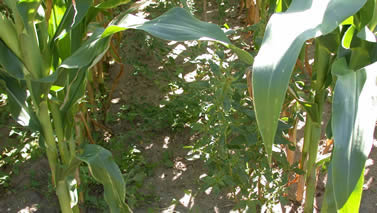
Expanding Use of Herbicide Tolerant Crops
If you have already converted a large percentage of your soybean acreage to Roundup Ready soybeans you may feel somewhat concerned about the potential for promoting weed resistance to glyphosate. This apprehension may increase as you swing more of your corn acreage into a Roundup Ready program. Weed resistance stewardship promotes the rotation of crops, tillage practices and herbicides. You may also consider that adding some conventional herbicides to your Roundup Ready program either as sequential applications or as tank mixes fits the stewardship aims. The conventional chemistry component will help in reducing the pressure to select weeds that might otherwise get exposed only to glyphosate.
 |
Timing Concerns
(C. critical weed free period (3-4 leaf corn)? If so, some additional flexibility in your herbicide program might reduce the potential yield loss associated with the poor timing of your first glyphosate application. This strategy could be one of laying down a low cost pre-emerge program, that gives some early season weed control, and builds some flexibility into your post-emerge spray schedule. Then, even if you can’t get to that field with your first glyphosate application until the crop is at the 6-7 leaf stage, yield loss has been negligible and you clean it up with a single post-emerge trip over the field. This may not be a low cost herbicide system, but eliminating the yield losses from poor timing may make it a profit optimizer. A potential side benefit is that on some fields or in some years the “bare bones” pre-emerge program may do the job beautifully and you walk away with herbicides saving as well.
2007 Research Trials
OCPA supported research by Dr. Clarence Swanton, University of Guelph in 2007 to examine a range of these flexible weed control options involving herbicide tolerant hybrid corn and combinations of conventional and Roundup Ready approaches. Highlights from this work included:
| 1) | A single application of Roundup at the 3-4 leaf stage produced yields equal to the weed-free control. This supports the idea that if you can always be on-time, the most economical weed control approach will usually be that early application of glyphosate. |
| 2) | Sequential applications of Roundup (3-4 leaf, followed by 7-8 leaf stage) gave improved later season weed control but did not improve yields over the single application. Cleaner fields at harvest may require a second application of glyphosate, and on occasion (but not at these two sites) improve yields. |
| 3) | Tank mixing Aatrex, or Primextra II Magnum with Roundup at the 3-4 leaf stage had results similar to the two applications of Roundup. Yields were not significantly different from the single application of Roundup alone but late season weed control was improved without the need for the additional pass over the field. |
| 4) | Where Aatrex, ConvergePro (isoxaflutole plus atrazine), or Primextra II Magnum were applied pre-emergence at either full or half-rates, followed by a sequential application of Roundup when the corn was at the 7-8 leaf stage, corn yields were not different from those obtained with the early (3-4 leaf stage) application of Roundup. In this research, so far, any of the pre-emerge options (some costing very little) seemed to significantly buffer the timing for the first application. |
| 5) | The flexible program of pre-emerge followed by Roundup was also effective where herbicide performance was not consistent between locations. For example, at Woodstock, ConvergePro (isoxaflutole plus atrazine) applied pre-emergence at half-rate provided excellent broad spectrum weed control. Whereas, at Elora, this treatment was less effective and required a sequential application of Roundup when corn was at the 7-8 leaf stage to control redroot pigweed and green foxtail (see results in Table 1). This flexible weed management strategy reduced risk to management by widening the window for herbicide application as well as optimizing crop yields and opportunities for profitability. |
| Table 1. Impact of weed control strategies on corn yield in 2007 at sites in Elora and Woodstock. C. Swanton and K. Chandler, U. of Guelph |
||
| Herbicide Program |
Elora Corn Yield (bu/ac) |
Woodstock Corn Yield (bu/ac) |
| Weedy Check | 119 |
31 |
| Weed Free Control | 145 |
147 |
| Half-rate ConvergePro (isoxaflutole plus atrazine) applied pre-emerge. | 128 |
158 |
| Half-rate ConvergePro (isoxaflutole plus atrazine) applied pre-emerge with subsequent application of Roundup WeatherMax at 7-8 leaf stage corn. |
151 |
153 |
Dr. Swanton is quick to point out that he is not a proponent of reduced rate herbicide programs. However, this research does highlight the concept that low cost pre-emerge programs may add significant flexibility to a Roundup Ready weed control program both in terms of modes of action and spray timing. Swanton adds that growers who can capitalize most on this flexible approach to weed management will be ones that understand the concept of the critical weed free period and who are willing to monitor weed pressure and crop stages to make the best decisions.
Producer uptake on this concept has been varied as it has been discussed at grower meetings over the past year. Some see it as a way to take the pressure off of June spray schedules and protect yield. Producers who use “weed and feed” programs and apply herbicide with their 28% N solution embrace it as a way to increase flexibility and perhaps lower costs even as they move to more Roundup Ready corn. Others see it as a waste of money after already incurring the additional cost for herbicide tolerant technology in their seed corn. Both points of view can be correct depending on the dynamics of the cropping operation.
Acknowledgements
Research featured in this article was supported by the Ontario Corn Producers’ Association, Canada and the Province of Ontario under the Canada-Ontario Research and Development (CORD) Program.